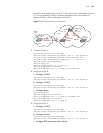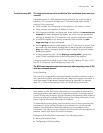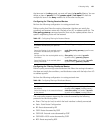152 CHAPTER 5: IP ROUTING PROTOCOL OPERATION
■ Troubleshooting Routing Policies
■ Limiting Route Capacity
■ Configuring Route Capacity
Routing Information
Filters
The Switch 8800 supports four kinds of filters, route-policy, acl, ip-prefix, and
community-list. The following sections introduce these filters:
■ Route Policy
■ ACL
■ IP Prefix
■ Community List
Route Policy
A route map is used for matching some attributes with given routing information
and the attributes of the information will be set if the conditions are satisfied.
A route map can include multiple nodes. Each node is a unit for match testing,
and the nodes are matched in a sequence-number-based order. Each node
includes a set of if-match and apply clauses. The if-match clauses define the
matching rules and the matching objects are attributes of routing information. The
comparison of if-match clauses for a node uses a series of Boolean and
statements. As a result, a match is found if all the matching conditions specified by
the if-match clauses are satisfied. The apply clause specifies the actions that are
performed after the node match test concerning the attribute settings of the route
information.
The comparison of different nodes in a route policy uses a Boolean or statement.
The system examines the nodes in the route policy in sequence. Once the route is
permitted by a single node in the route policy, the route passes the matching test
of the route policy without attempting the test of the next node.
ACL
The access control list (ACL) used by the route policy can be divided into three
types: advanced ACL, basic ACL, and Layer-2 ACL.
A basic ACL is usually used for routing information filtering. When the user
defines the ACL, the user defines the range of an IP address, subnet for the
destination network segment address, or the next-hop address of the routing
information. If an advanced ACL is used, perform the matching operation by the
specified source address range. Layer-2 ACLs
IP Prefix
The function of the ip-prefix is similar to that of the acl, but it is more flexible and
easier for users to understand. When the ip-prefix is applied to routing
information filtering, its matching objects are the destination address information,
and the domain of the routing information. In addition, in the ip-prefix, you can
specify the gateway options and require it to receive only the routing information
distributed by certain routers.


















